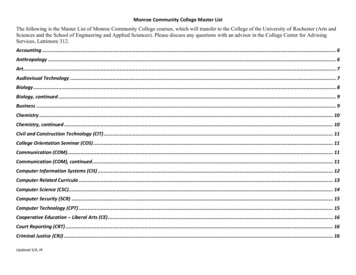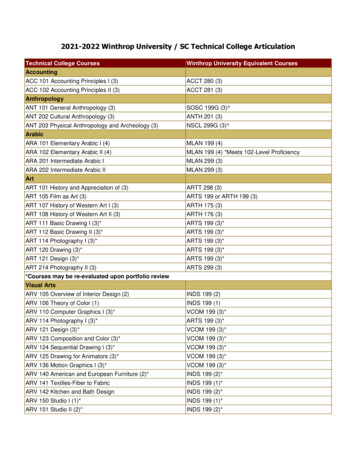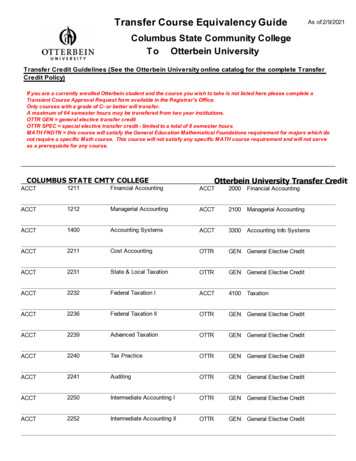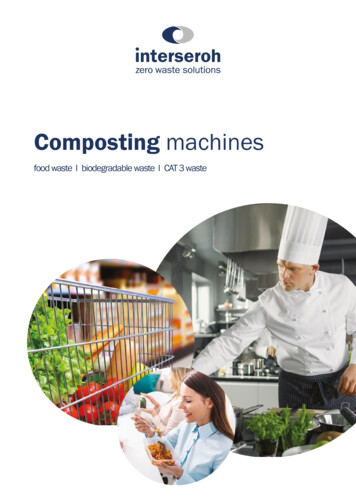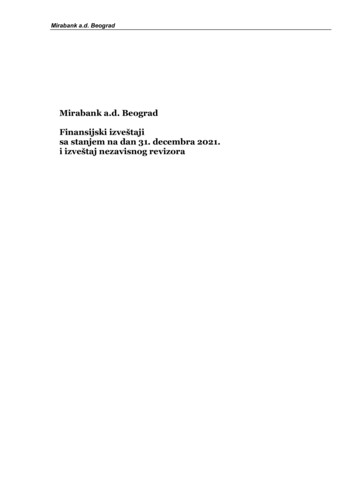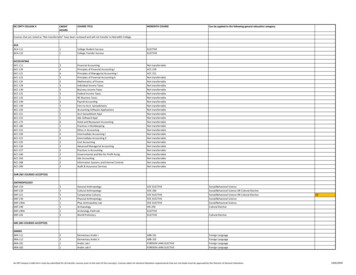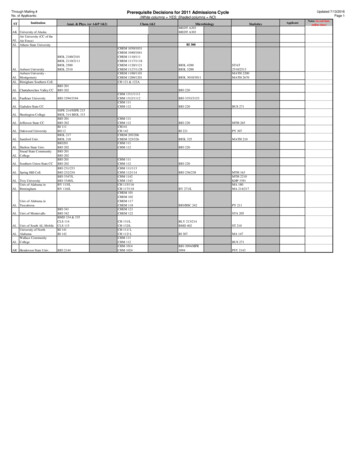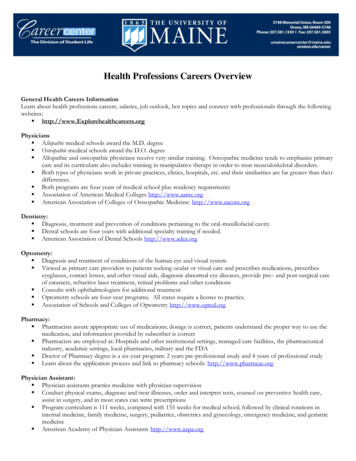
Transcription
GENERAL MICROBIOLOGY (BIO3302)SYLLABUSNEW YORK CITYCOLLEGE OFTECHNOLOGYSchool of Arts and SciencesDepartment of Biological SciencesThe City University Of NewYorkCourse InformationCourse title:MicrobiologyCourse code:BIO33024 credit hoursCredit Hours:Prerequisite:T ext b o o ks:2 hours lecture and 4 hours lab per week for 15 weeksBIO 1101, BIO 2311 or Equivalent, CUNY ReadingLectureMicrobiology Fundamentals: A Clinical Approach 4th edition,M. K. Cowan. McGraw Hill Publishing. ISBN: 126070243X /9781260786057LabLaboratory Manual, Microbiology Fundamentals: A Clinical Approach4th edition, Steven Obenauf, McGraw Hill Publishing.ISBN: 9781260786095Grading Procedure (see Grading Policies for details)Lecture: 50% of the final grade (based on 4one hour exams)Lab: 50% of the final grade (based on minimum of4 written exams and 2 practical exams)Course CoordinatorsProf. Rena DabydeenProf. Ralph AlcendorPhone:Dabydeen: itytech.cuny.eduRAlcendor@citytech.cuny.edu
Course DescriptionThe f undamentals of microbiology: Lectures are f ocused on the structure of prokaryotic and eukaryoticmicroorganisms, host-microbe interactions, immunity and human inf ectious diseases. Laboratorysessions are f ocused on pure culture techniques, methods of staining and the colonial and biochemicalidentif ication of microorganisms.Learning Objectives – LectureAf ter completion of the lecture component of the course, successful students should be able to:1. Explain the ubiquity and the wide range of ecological habitats of microorganisms in nature.2. Appreciate the diversity of microorganisms and microbial communities and recognize how microorganisms solvethe f undamental problems their environments present.3. Understand the role microorganisms play in the medicine, biotechnology and other industries, like wine andbaking, that are important to human well-being.4. Identif y methods used in the identification of organisms involved in diseases and disease treatment andprevention.5. Def ine and explain basic medical terminology as related to Microbiology6. Recognize how the underlying principles of epidemiology of disease and pathogenicity of specific microbes affecthuman health.CUNY Common Core Learning Outcomes1. Identif y and apply the fundamental concepts and methods in microbiology.2. Use appropriate technologies to gather, analyze and interpret data and to communicate the findings.3. Understand the scientific principles underlying matters of policy or public concern in which microbiologyplays a role.4. Demonstrate how tools of science, mathematics, technology, or formal analysis can be used to analyzeproblems and develop solutions.5. Identif y and apply research ethics and unbiased assessment in gathering and reporting scientific data.LECTURE OUTLINEWeek12Topic ofDiscussionChapter 1Introduction toMicrobes and TheirBuilding BlocksChapter 3 BacteriaProkaryoticStructureReading Assignment1.2.3.4.Microbes: Tiny but MightyHistory of MicrobiologyNaming, Classifying and Identifying MicroorganismsMacromolecules: Superstructures of Life1.2.3.4.5.Form and Function of BacteriaExternal StructuresThe wall and Membrane(s)Bacterial Internal StructuresClassification Systems for Bacteria2
34Chapter 6Microbial Nutritionand Growth1.2.3.Microbial NutritionEnvironmental Factors That Influence MicrobesBacterial GrowthChapter 71.2.3.4.Metabolism and the Role of EnzymesThe Pursuit and Utilization of EnergyCatabolismAnabolism and Crossing Pathways of Metabolism1.2.3.4.5.Introduction to Genetics and GenesTranscription and TranslationGenetic Regulation of Protein SynthesisDNA Replication and Recombination eventsMutations: Changes in the Genetic Code1.2.3.4.5.6.The Position of Viruses in the Biological SpectrumGeneral Structure of VirusesModels of Viral MultiplicationTechniques in Cultivating and Identifying Animal VirusesOther Noncellular Infectious AgentsViruses and Human HealthMicrobialMetabolism5Exam 1Chapter 8Microbial Genetics6Chapter 5Viral Structure andMultiplication3
7Chapter 4Eukaryotic CellsandMicroorganisms81011Structures of the Eukaryotic CellsThe FungiThe Protozoa1.2.The Human HostProgress of an Infection Portal of Entry Signs and SymptomsEpidemiologyExam 2Chapter 11InteractionsBetween Microbesand Humans91.2.3.Chapter 12Host Defenses I:Overview andNonspecificDefensesChapter 13Host Defenses II:Specific Immunityand Immunization3.1. Defense Mechanisms of the Host2. The Second and Third Lines of Defense: An Overview3. The Second Line of Defense1. Specific Immunity: The Third and Final Line of Defense2. Stage I: Development of Lymphocyte Diversity3. Stage II: Presentation of AntigensChapter 134. Stages III and IV: T-Cell ResponseHost Defenses II:5. Stages III and IV: B-Cell ResponseSpecific Immunity6. Vaccinationand Immunization(Cont.)1. Types of Allergic ReactionsChapter 142. Inappropriate Response to Self: AutoimmunityDisorders in3. ImmunodeficiencesImmunityExam 3Chapter 19InfectiousDiseases Affectingthe RespiratorySystem1. The Respiratory Tract and Its Defenses2. Normal Flora of the Respiratory System3. Microbial Diseases of the Upper Respiratory tract Streptococcal Pharyngitis Scarlet Fever Diphtheria The Common Cold4. Diseases of the Lower Respiratory Tract Pertussis Tuberculosis Pneumonia Influenza4
12Chapter 201.2.3.InfectiousDiseasesAffecting theGastrointestinalTract13Chapter 21InfectiousDiseasesAffecting theGenitourinarySystem14Chapter 16InfectiousDiseasesAffecting theSkin and EyesChapter 18InfectiousDiseasesAffecting theCardiovascularand LymphaticSystems4.1.2.3.4.The Gastrointestinal Tract and Its DefensesNormal Biota of the Gastrointestinal TractBacterial Diseases of the Mouth (Oral Cavity) Dental Caries Periodontal DiseasesBacterial Diseases of the Lower Gastrointestinal Tract Staphylococcal Food Poisoning Shigellosis (Bacillary Dysentery) Salmonellosis and Typhoid Fever Cholera Helicobacter Peptic Ulcer DiseaseThe Genitourinary Tract and Its DefensesNormal Biota of the Genitourinary TractUrinary Tract Infections (UTI)Sexually Transmitted Diseases (STD) 1.2.3.GonorrheaSyphilisTrichomoniasisGenital HerpesGenital WartsThe Skin and Its DefensesSkin Diseases Caused by Microorganisms: Acne Measles Small Pox Chicken Pox Rubella Anthrax GangreneCardiovascular and Lymphatic System DiseasesCaused by Microorganisms: Septicemia, Sepsis and Septic Shock Bacterial Endocarditis Elephantiasis15Final Exam5
Laboratory ScheduleThe Acid-fast stain (Ziehl-Neelsen).Endospore and capsule staining. Negative staining.7.8.Review of Gram Staining and Streak Plate methods. Isolation of pure culture.The use of Enriched, Selective and Differential media – BA, MS, MC, PEA.Week 55.6.9. Epidemiology and related topics. Universal Precautions (discussion).10. Practical Exam 1. Written Exam 1.Week 64.Introduction to Staining and Simple Stain. Morphological features of bacteria –discussion only.The Gram stain. Bacterial anatomy – discussion only.11. Biochemical Activities – Discussion. Extracellular degradation, Hydrolytic Enzymes.12. Carbohydrate fermentation: Phenol red broth and Triple Sugar Iron (TSI) agar.Week 73.13. IMViC test. Multiple Test Systems: SIM, Litmus milk,14. Urease test, Nitrate reduction test, Catalase and Oxidase test.Week 8Laboratory Safety. The use and care of the microscope. Review of the Metric system.Aseptic Techniques. Inoculation and transfer techniques. Streak plate.15. Miniature Systems – EnteroPluri Test and API. Review of Biochemical tests.16. Written Exam 2. The Fungi - Molds, Yeast and Mushrooms.Week 91.2.17. The protozoa.18. The effect of Temperature and pH on microorganisms.Week 10Week 4Week 3Week 2Week 1EXERCISE19. Atmospheric Oxygen Requirements. Cultivation of Anaerobes.20. The inhibitory action of heavy metals*. The inhibitory action of disinfectants.6
Week 1121. Antibiotic susceptibility testing: The antibiogram.22. Immunology: Discussion (Antigen-antibody reactions), Agglutination (S t a p h o re x ) ,Precipitation and ELISA.Week 1223. Written Exam 3. Practical Exam 2 – Cultivation of unknowns.24. Practical Exam 2 continues.Week 1325. Practical Exam 2 concludes. Pathogenic Microorganisms of the Skin*.26. Microorganisms of the Mouth and Dental Caries*. Pathogenic microorganisms of theGastrointestinal Tract. Activities with Blood agar and Sterptococcus mitis/salivar ius agar.Week 1427. Pathogenic Microorganisms of the Respiratory Tract*.28. Pathogenic Microorganisms of the Urogenital System and Sexually TransmittedDiseases (STDs)*.Week 1529. Helminthology.30. Final Written Exam.* Discussion or limited exercises. Supplemental materials to be provided. Read Cowan’s Textbook.Laboratory LearningOutcomes1. The Use and Care of the Microscope Identify the parts of the microscope, and understand their functions. Demonstrate the proper method of focusing, changing objectives, carrying the microscope, andcleaning the microscope. Calculate the total magnification of any ocular and objective combination. Prepare a temporary wet mount for the examination of a specimen. Use the microscope, especially the oil immersion lens, effectively. Define and understand the following terms and concepts: resolving power, parfocal, field ofview, and magnification.2. Aseptic Techniques. Transfer and Colony Selection TechniquesTo perform basic bacteriological transfer techniques using broth and agar cultures.Handle bacteriological cultures an d i n o c ul at i o n l o o p s aseptically.Recognize selected properties of bacterial broth and agar slant cultures.Distinguish basic features of bacterial colonies, broth cultures, and agar slant growths.3. Bacterial Smears and Simple StainsEffectively perform the appropriate aseptic techniques required in the handling of bacterial cultures.Prepare and stain bacterial smears.Locate, examine, and interpret stained bacterial smears.Distinguish among basic bacterial shapes.Develop a perspective on size relationships among bacteria, and blood cells.4. The Gram Stain7
Carry out the Gram stain procedure correctly.Differentiate between Gram-positive and Gram-negative reactions.Interpret Gram stain reactions with unknown specimens.Recognize the importance of the Gram stain in disease detection and diagnosis.List at least two bacterial species to be Gram-positive and two species to be Gram-negative.5. The Acid-Fast StainPerform the acid-fast procedure.Distinguish between acid-fast and non-acid-fast reactions.Interpret acid-fast reactions with unknown specimens.Recognize the importance of the acid-fast procedure in disease detection and diagnosis.List at least two bacterial species known to be acid-fast positive.6. Spore and Capsule StainsCarry out a standard procedure for the demonstration of bacterial spores.Detect the presence of bacterial spores in a culture.Distinguish between vegetative cells and bacterial spores.Carry out a negative staining technique.Differentiate between bacterial capsules and artifacts.7. Review of Gram Staining and Streak Plate methods. Isolation of pure culture.Isolate individual colonies from mixed cultures by means of the streak plateRecognize selected properties of bacterial colonies on agar plates.Recognize the advantages and limitations of culture characteristics in the identification of bacterial species.8. The Use of Selective and Differential Media Understand the basic differences among differential, enriched, selective, and combined media. Recognize the role of such media in the isolation and identification of microorganisms.9. Epidemiology and Related Topics. Universal Precautions.Recognize the importance of using universal precautions to prevent n o s o c om ial infections.Give examples of the applications of universal precautions .Discuss the concept of nosocomial infections – Healthcare-associated Infections (HAI).Learn about collection and transportation of specimens for microbiological testing.Recognize the possibility of transmission of a disease associated with collection and handling of specimens.Examine the importance of hand washing for finger prints; Use the “glow” germ lotion.Examine the normal flora in the throat, tooth plaque, nose etc.11. Extracellular Degradation Perform and interpret tests for the hydrolysis of starch and gelatin. Explain how these test results can be used in microbial identification. Explain the role of extracellular enzymes in providing nutrients for cellular metabolism.12. Carbohydrate fermentation: Phenol red broth and Triple Sugar-Iron Agar Perform and interpret tests for selected aspects of carbohydrate metabolism. Explain the role of the intracellular enzymes involved in carbohydrate metabolism. Explain how selected test results can be used in microbial identification.13. IMViC test, Multiple Test Systems: Litmus milk, SIM Inoculate the various multiple-test media. Identify and interpret the characteristic reactions produced by microorganisms in multiple test media. Recognize the value of multiple-test media in the identification of microorganisms.14. Urease test, Nitrate Reduction test, Catalase and Oxidase test Learn to perform and interpret results for Urease test and Nitrate Reduction.8
Perform and interpret test for catalase function. Recognize the respective values of the oxidase and catalase tests in the identification of bacterial species.15. Miniature Systems – EnteroPluri Test and API. Review of Biochemical tests.Rec o g n i ze the r o l e and ad v an tag es of us i n g mi n i atur e s y s tems in mi c r o bi o lo gy d i ag n os tic sIn o c ul ate En ter o tube ( o n e per tabl e) wi th an un k n o wn bac ter i al s tr ai n .Demo n s tr ate the use of APIUn d er s tan d the use of all bi o c h emi c al tes ts for i d en ti fic atio n of bac ter i a. 16. The Fungus Recognize the macroscopic (mycelial phase) and microscopic features of common molds and yeasts. Recognize the major structures of fleshy mushrooms. Identify fungal structures in foods and other materials. Learn the importance of fungi for causing infectious diseases in humans and especially in immunocompromised individuals, most common pathogens and their diagnosis. Identify fungi and spores in permanent smears.17. The Protozoa Recognize characteristic properties of protozoa. Learn to prepare wet mount with different live protozoa from pond water. Distinguish between prokaryotic and eukaryotic cellular organization in microorganisms. Observe food vacuole formation in certain protozoa. Discuss diseases caused by Protozoa. Identify pathogenic protozoa in permanent smears.18. The Effect of Temperature and pH on Microorganisms Compare the effectiveness of dry-heating processes and moist-heating methods. List the advantages and disadvantages of methods using high temperatures for microbial killing. Give examples of the application of high-temperature methods for control of microorganisms. Discuss the concept of autoclave, being the most efficient method of sterilization. Recognize the influence of the hydrogen ion concentration (pH) on microbial growth. Recognize that an optimum concentration of hydrogen ions exists for each organism in which it grows best. Identify the general pH range in which microbial growth can occur.19. Atmospheric Oxygen Requirement Discuss the different types of oxygen requirements (aerobic and anaerobic respiration and fermentation). Discuss oxidative and anaerobic metabolism.20. The Inhibitory Action of Heavy Metals, and Disinfectants Recognize the inhibitory actions of heavy metals (oligodynamic action). Compare the inhibitory effects of heavy metal compounds and disinfectants. Use a filter paper disk d i ffus i o n method for testing purposes.21. Antibiotic Susceptibility Testing Perform an antibiotic sensitivity test on a bacterial culture, by using the Kirby-Bauer disc diffusion technique. Measure the zone of inhibition and interpret the results, using a table for different antibiotics. Distinguish the relative resistance and sensitivity of bacterial cultures to selected antibiotics. Discuss the emergence of multi-drug resistance.22. Immunology Discuss the main components of immune reactions – antigens and antibodies. Perform microbial slide agglutination test ( Stap h o r ex ) and interpret typical test results. Recognize the value of agglutination tests in the diagnosis of certain microbial diseases. Understand the basis of blood typing. Recognize the major differentiating features between precipitation and agglutination reactions. Discuss different type of precipitation tests. D e f i n e E L I S A a n d u nderstand how an ELISA can be used to detect both antigen and antibodies.9
25. Microorganisms of the SkinList several common microbial infections of the skin.Recognize the significance of the intact skin as a barrier to microbial disease agents.Distinguish between various microbial pathogens of the skin.Interpret specific diagnostic tests for Staphylococcus aureus, including coagulase, mannitol fermentation andDNAse tests. Interpret specific tests used for the identification of Streptococcus species, including bacitracin sensitivity,CAMP reaction, Bi l e - esculin test and growth in 6.6% sodium chloride.26. Microorganisms of the Mouth and Dental Caries. Microorganism s of the Gastrointestinal Tract List several common microbial infections of the gastrointestinal tract. Describe different mechanisms of resistance in the digestive tract Interpret standard procedures used in the identification of selected gastrointestinal pathogens. Differentiate between S. mitis and S. Salivarius27. Microorganisms of the Respiratory Tract List several common infections of the respiratory tract. Recognize general cultural characteristics of selected potential bacterial pathogens. Interpret the results of the optochin test for Streptococcus pneumoniae. Identify selected fungal pathogens that cause respiratory infections Discuss viruses that cause respiratory diseases28. Pathogens of the Urogenital System and STD’s Recall the anatomy of the Urogenital System. Explain the types of urinary-tract infections (UTI). List common microbial pathogens and diseases of the genitourinary tract. Describe the general features of representative sexually transmitted diseases. List diagnostic features of selected STD’s.29. Helminthology Distinguish the adult tapeworms, roundworms and flukes. List the most common diseases from each type. Prophylaxis and treatment.Necessary MaterialsIn addition to the lecture textbook and the lab manual, you will need additional materials. For the lab, youwill need pencils, a pen, a lab coat, goggles and a sharpie. Long hair must be tied back. No high heels oropen toed shoes are permitted. Lab coats must be worn.Purchasing options and costs: this may varyLecture textbook (Cowan) at the Bookstore: 78 for renting 1 term 136 to purchase NEW Loosleaf; Here is the ISBN for that: 9781264028399The direct purchase link for the publisher McGraw tails?isbn 1264028393The price is 80 on the link.Laboratory Manual, Microbiology Fundamentals: A Clinical Approach 3rd edition, Steven Obenauf. 132 directly from the t/9781260163483.html?exactIsbn true#buying -options10
Attendance and LatenessStudents must attend both lecture and lab. This means that no more than 2 lecture or 3 lab absenceswill be tolerated. It is expected that you will be in your seat and ready to work at the start of each period.Any 2 latenesses will be considered to be equal to 1 absence.Temporary Conditions and Medical Reasons for AbsenceAccording to the CUNY Policy, faculty should never review medical documentation from a student. Instead, thestudent should go to the Student Accessibility Center (SAC) in L-237 (on the second floor where the Library andGeneral buildings meet). The SAC will review the documentation and give the student a letter to share with facultyif accommodations should be made.Accessibility StatementCity Tech is committed to supporting the educational goals of enrolled students with disabilities in the areas ofenrollment, academic advisement, tutoring, assistive technologies and testing accommodations. If you have orthink you may have a disability, you may be eligible for reasonable accommodations or academic adjustments asprovided under applicable federal, state and city laws. You may also request services for temporary conditions ormedical issues under certain circumstances. If you have questions about your eligibility or would like to seekaccommodation services or academic adjustments, please contact the Center for Student Accessibility at 300 JayStreet room L-237, Phone: 718-260-5143 or http://www.citytech.cuny.edu /accessibility /.Grading PolicyThe grade for the Microbiology course is computed by adding 50% of your lecture grade to 50% of your labgrade. There are 4 lecture examinations, which each cover roughly one quarter of the lecture work asindicated in the outline. For the lab, there are four written exams and two practical exams. There are also writtenassignments (suggestion: 4). Each of the written exams count for 15%, the two practical exams each count for10% and the written assignments count for 20%.ALL GRADES ARE COUNTED; NONE ARE DROPPED NOR ARE THEY CURVED.Letter GradeNumerical RangesAAB BBC 960-69.959.9 and belowPlagiarismStudents must write their own assignments in their own words. Whenever students take an idea, or apassage from another author, they must acknowledge that, both by using quotation marks whereappropriate and by proper referencing such as footnotes or citations. For the CityTech policies onplagiarism, see the following link: http://library.citytech.cuny.edu/instruction /pdf/plagiarismtips.pdfFor the CityTech policies on academic integrity see the following linkhttp://www.citytech.cuny.edu/abou tus/docs/policies/C T PolicyManual11 12.Options for BookOPTION 1 (LooseLeaf Physical Version): 9781260786057 Loose Leaf for Microbiology Fundamentals: A ClinicalApproach 4th Edition, Cowan NET PRICE 9811
OPTION 2 (eBook Only): McGraw Hill eBook Access Card 180 days for Microbiology Fundamentals: A ClinicalApproach9781266661013 NET PRICE 49.50OPTION 3 (Connect Access, Includes eBook): COWAN CNCT ACCSS CRD MCRB FNDMNTL 4th Edition9781260786033 NET PRICE 9512
COLLEGE OF TECHNOLOGY The City University Of New York School of Arts and Sciences Department of Biological Sciences Course Information Course title: Microbiology Course code: BIO3302 Credit Hours: 4 credit hours 2 hours lecture and 4 hours lab per week for 15 weeks Prerequisite: BIO 1101, BIO 2311 or Equivalent, CUNY Reading
